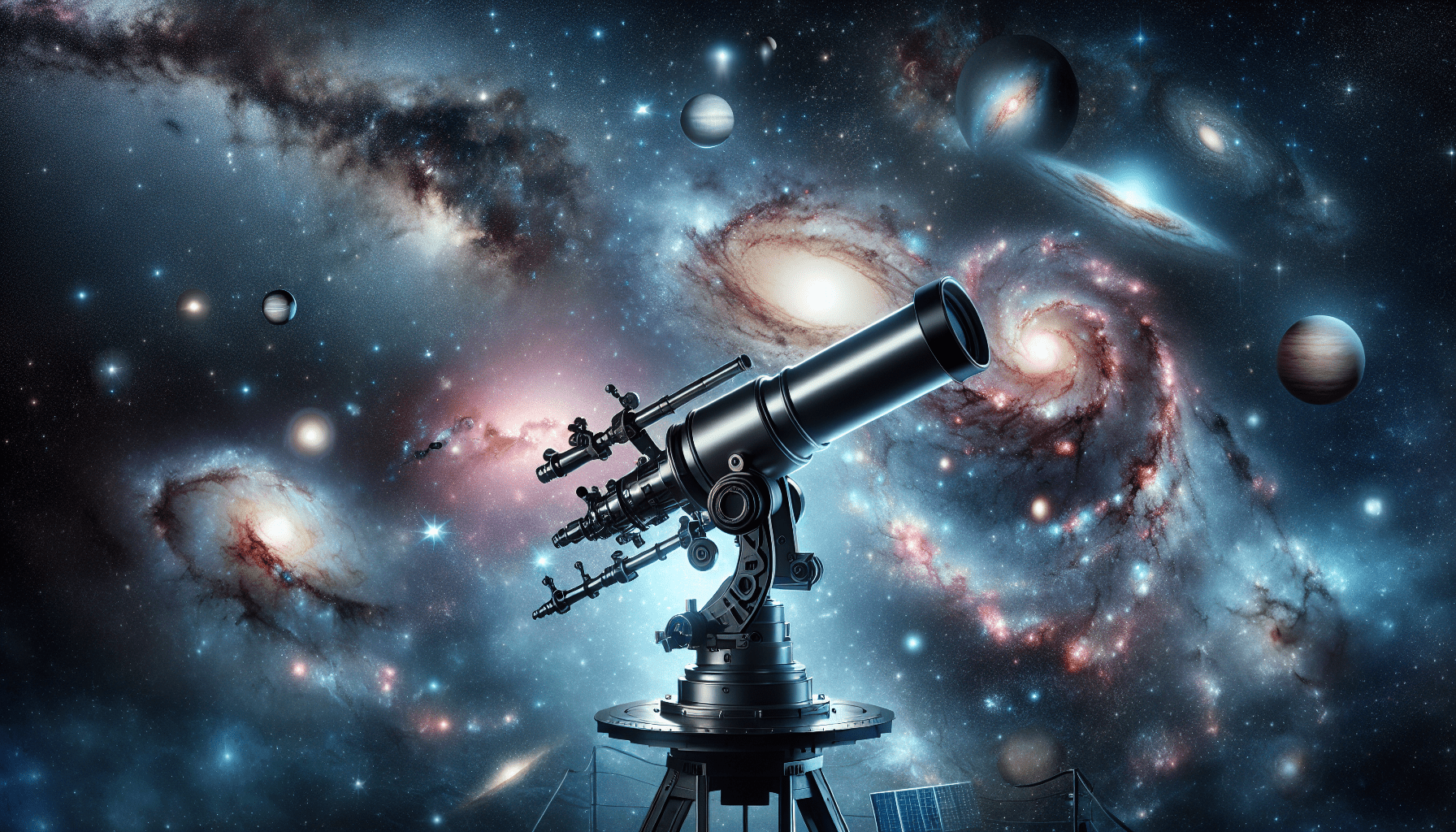“Exploring the Cosmos What Telescopes Reveal” unveils the profound wonders of the universe through the lens of telescopes. This article takes a closer look at the invaluable functions of telescopes, shedding light upon the two pivotal roles they play. By effortlessly extending human sight beyond the limitations of our naked eyes, telescopes offer a captivating glimpse into celestial bodies and distant galaxies, providing astronomers with crucial data for scientific exploration and discovery. Through meticulous observation and precise measurements, telescopes not only deepen our understanding of the cosmos but also allow us to marvel at its mesmerizing beauty.

Table of Contents
1. Introduction
Telescopes are essential tools for astronomers and scientists to explore and study the vast expanse of the cosmos. These devices have revolutionized our understanding of the universe by enabling us to observe celestial objects that are beyond the reach of our naked eyes. In this article, we will delve into the world of telescopes, their functions, types, and the invaluable knowledge they provide us about the universe.
Definition of telescopes
Telescopes are optical instruments designed to gather and magnify light from distant objects, allowing us to observe them in greater detail. By utilizing lenses or mirrors, telescopes can capture and focus light, enabling us to view objects that are otherwise too faint or distant for the human eye to perceive. They serve as windows to the cosmos, uncovering the mysteries of the universe.
Brief history of telescopes
The invention of the telescope marked a significant milestone in our understanding of the cosmos. The credit for creating the first telescope generally goes to Hans Lippershey, a Dutch optician, who is believed to have crafted a simple refracting telescope in the early 17th century. However, Galileo Galilei, an Italian astronomer, greatly improved upon the design and made groundbreaking astronomical discoveries using his own version of the telescope in 1609.
Since then, telescopes have undergone countless advancements and refinements. Notable figures like Sir Isaac Newton and Johannes Kepler contributed to the development of better telescopes by introducing the concept of reflecting telescopes and improving upon the optics involved. Today, modern telescopes have reached unprecedented levels of sophistication, ushering in a new era of astronomical exploration.
2. Function of Telescopes
1. Observation and Collection of Light
The primary function of telescopes is to gather as much light as possible from distant celestial objects. By collecting light from these objects, telescopes allow astronomers to study them in detail, revealing intricate features and providing insights into their composition, structure, and behavior. The larger the aperture of the telescope, the more light it can collect, leading to more detailed observations.
Furthermore, telescopes can also detect different wavelengths of light, including visible, infrared, and X-ray radiation. This ability enables scientists to study objects that emit light at specific wavelengths, providing additional information about their properties and characteristics.
2. Magnification and Resolution
Telescopes also possess the ability to magnify the images of celestial objects, allowing astronomers to examine them in greater detail. By increasing the apparent size of the objects, telescopes unveil intricate features that would otherwise be indistinguishable. This magnification capability plays a crucial role in studying celestial bodies such as planets, stars, and galaxies.
Additionally, telescopes with high resolution can discern fine details and separate closely spaced objects. Resolution is determined by the diameter of the telescope’s objective, which is the primary lens or mirror responsible for capturing light. Higher resolution telescopes can reveal finer structures, enabling scientists to study intricate phenomena like planetary surfaces, stellar atmospheres, and intricate galaxy formations.
Exploring the Cosmos What Telescopes Reveal
3. Types of Telescopes
Telescopes come in various designs and configurations, each catering to specific observing requirements. The three main types of telescopes are refracting telescopes, reflecting telescopes, and catadioptric telescopes.
1. Refracting Telescopes
Refracting telescopes use a lens as the primary objective to gather light and form an image. These telescopes utilize the refractive properties of lenses to focus light onto a focal plane where eyepieces or cameras can capture the image. Refracting telescopes are known for their simplicity and durability, and they are commonly used for amateur astronomy purposes.
However, refracting telescopes have inherent limitations, such as chromatic aberration, which causes different colors of light to focus at slightly different points, resulting in color fringing around objects. This can affect the clarity and quality of the observed images.
2. Reflecting Telescopes
Reflecting telescopes employ a mirror as the primary objective to gather and reflect light. These telescopes use the reflective properties of mirrors to focus the light onto a secondary mirror, which then directs it to either an eyepiece or a camera. Reflecting telescopes, pioneered by Sir Isaac Newton, have become the preferred choice for professional astronomers.
Reflecting telescopes eliminate the issue of chromatic aberration found in refracting telescopes, resulting in much sharper and clearer images. They also have the advantage of being able to construct larger apertures, allowing for better light-gathering capabilities.
3. Catadioptric Telescopes
Catadioptric telescopes combine the features of both refracting and reflecting telescopes. These telescopes utilize a combination of lenses and mirrors to focus light onto the focal plane. Catadioptric telescopes offer a compact design, making them portable and convenient for both professional and amateur astronomers.
One popular design of catadioptric telescope is the Schmidt-Cassegrain telescope, which uses a corrector plate, mirrors, and lenses to achieve an effective focal length within a compact tube. This design provides excellent image quality and versatility.
4. Optical Telescopes
Optical telescopes, encompassing both refracting and reflecting telescopes, are the most common type of telescope used in astronomy. These telescopes employ light-gathering optics to observe celestial objects in the visible range of the electromagnetic spectrum.
1. Advantages of Optical Telescopes
Optical telescopes have several advantages that have made them a staple tool for astronomers. Firstly, they provide high-resolution images, enabling scientists to study the fine details of planets, stars, and galaxies. Optical telescopes, especially reflecting telescopes, can achieve large apertures, allowing them to gather copious amounts of light and enhance image brightness.
Another advantage is their versatility. Optical telescopes can be equipped with a wide range of instruments, such as spectrographs and CCD cameras, which enable scientists to analyze the composition, temperature, and motion of celestial objects. These instruments expand the capabilities of optical telescopes, leading to a deeper understanding of the universe.
2. Disadvantages of Optical Telescopes
Despite their advantages, optical telescopes also have drawbacks. One significant limitation arises from the Earth’s atmosphere. Atmospheric turbulence can distort and blur the images obtained from optical telescopes, degrading their resolution and limiting the amount of detail captured. This issue has led to the development of techniques such as adaptive optics to compensate for atmospheric distortions.
Moreover, optical telescopes are affected by light pollution, which refers to the excessive artificial lighting in urban areas that obscures the visibility of celestial objects. Light pollution can severely hamper astronomers’ ability to observe faint or distant objects, necessitating the need for remote observing sites or observatories located in dark sky regions.
3. Examples of Optical Telescopes
Some famous examples of optical telescopes include the Hubble Space Telescope, the Keck Observatory, and the Large Binocular Telescope. These telescopes have played pivotal roles in numerous astronomical discoveries and have significantly contributed to expanding our understanding of the universe.

5. Radio Telescopes
While optical telescopes observe visible light, radio telescopes are designed to detect and study radio waves emitted by celestial objects. Radio waves, with much larger wavelengths than visible light, provide a unique perspective on the universe.
1. How Radio Telescopes Work
Radio telescopes operate by capturing radio waves, which are then focused and amplified to create measurable electronic signals. These signals are subsequently converted into images or data that scientists can analyze. Radio telescopes are often built with large metallic dishes or arrays of antennas to collect and focus the weak radio signals emitted by celestial sources.
2. Advantages of Radio Telescopes
Radio telescopes offer several advantages over optical telescopes. Firstly, radio waves can penetrate through interstellar dust, allowing scientists to study objects that are otherwise obscured in visible light. This ability provides unique insights into phenomena such as star formation, pulsars, and molecular clouds.
Additionally, radio telescopes can observe celestial objects during both day and night, making them less susceptible to atmospheric limitations, such as glare and turbulence. This characteristic enables continuous observations and longer data collection periods, resulting in a more comprehensive understanding of cosmic processes.
3. Disadvantages of Radio Telescopes
Despite their advantages, radio telescopes also face certain limitations. One significant challenge is the interference caused by human-made radio signals. In modern times, the increasing use of wireless communication technologies has led to an abundance of radio frequency interference, creating difficulties for radio astronomers. Efforts are made to minimize this interference through the establishment of radio-quiet zones and the development of sophisticated signal processing techniques.
Moreover, the resolution of radio telescopes is limited by their large wavelengths. Unlike optical telescopes, which can resolve fine details due to their shorter wavelengths, radio telescopes have lower resolution and are unable to provide fine-scale images. However, techniques such as interferometry, which combines signals from multiple telescopes, can improve the resolution and provide higher-quality images.
4. Examples of Radio Telescopes
Some prominent radio telescopes include the Arecibo Observatory in Puerto Rico, the Very Large Array (VLA) in New Mexico, and the Parkes Observatory in Australia. These facilities have played crucial roles in numerous discoveries, such as the detection of pulsars and the mapping of the cosmic microwave background radiation.
6. Space Telescopes
Space telescopes, as the name suggests, are telescopes deployed in outer space to observe celestial objects without the hindrances posed by Earth’s atmosphere. These advanced instruments have opened up new frontiers in astronomy and have provided unparalleled views of the cosmos.
1. Benefits of Space Telescopes
Space telescopes offer several advantages that make them indispensable for scientific research. Firstly, they are unaffected by atmospheric distortions, allowing for significantly sharper and clearer images. This advantage has led to groundbreaking discoveries, such as the Hubble Space Telescope’s observations of distant galaxies and the existence of dark energy.
Furthermore, space telescopes can observe various wavelengths of light, including ultraviolet and X-ray radiation. The Earth’s atmosphere blocks much of this high-energy radiation, making it inaccessible to ground-based telescopes. By utilizing space-based platforms, scientists can study energetic processes, such as supernovae, quasars, and black holes, that emit significant amounts of X-rays and ultraviolet light.
2. Examples of Space Telescopes
The Hubble Space Telescope, launched in 1990, is undoubtedly one of the most iconic space telescopes. It has revolutionized our understanding of the universe by capturing stunning images of galaxies, nebulae, and other celestial objects with unprecedented clarity. The Hubble Space Telescope has made significant contributions to various fields of astronomy and has become synonymous with the triumphs of space exploration.
Other notable space telescopes include the Chandra X-ray Observatory, designed to study X-rays emitted by hot gases in galaxy clusters and other X-ray sources, and the Spitzer Space Telescope, which focuses on infrared observations to study star and planet formation processes.

7. Infrared and X-ray Telescopes
Infrared and X-ray telescopes play critical roles in unveiling the hidden mysteries of the universe. These telescopes enable scientists to study celestial objects that emit radiation at these specific wavelengths, providing unique insights into various phenomena.
1. Importance of Infrared and X-ray Observations
Infrared observations are crucial for studying cool objects, such as dust clouds, molecular clouds, and newly forming stars. These objects emit most of their radiation in the infrared portion of the electromagnetic spectrum, making infrared telescopes invaluable for investigating their properties and processes. Infrared observations also allow astronomers to peer through interstellar dust and observe objects that are obscured in visible light.
X-ray observations, on the other hand, are essential for studying high-energy events and sources, such as supernovae, black holes, and quasars. X-ray telescopes can detect X-rays emitted by these energetic phenomena, providing critical information about their physical properties, including temperature, density, and emission mechanisms.
2. Advantages of Infrared and X-ray Telescopes
Infrared and X-ray telescopes offer unique advantages that are not present in optical telescopes. Infrared observations can penetrate interstellar dust, revealing the hidden structures and processes occurring within. This capability allows astronomers to study the formation of stars, the evolution of galaxies, and the properties of exoplanets.
X-ray telescopes, on the other hand, provide a window into the high-energy universe. X-rays are emitted by extreme celestial objects, such as black holes and neutron stars, as well as by processes involving hot plasmas and shockwaves. By capturing X-rays, scientists can unravel the physical properties and dynamics of these extraordinary phenomena.
3. Examples of Infrared and X-ray Telescopes
The Spitzer Space Telescope, previously mentioned as a space telescope, is a prime example of an infrared telescope. It has provided valuable insights into the formation and evolution of stars and planetary systems.
One notable X-ray telescope is the Chandra X-ray Observatory, another space-based telescope that has been instrumental in studying X-ray sources such as supernovae remnants, black holes, and active galactic nuclei. Chandra’s high-resolution X-ray images have significantly contributed to our understanding of these energetic phenomena.
8. What Telescopes Reveal
Telescopes, regardless of their type or wavelength range, have enabled scientists to uncover a wealth of knowledge about the universe. They have unveiled hidden worlds and unveiled the grandeur of cosmic entities. Here are some of the remarkable discoveries made possible by telescopes.
1. Exoplanets and Solar Systems
Telescopes have played a pivotal role in the discovery and study of exoplanets, celestial bodies orbiting stars outside our solar system. By monitoring the subtle changes in starlight caused by an exoplanet’s presence, telescopes have detected thousands of exoplanets, revealing a diversity of planetary systems far beyond our own.
Telescopes have also provided insights into our own solar system, allowing astronomers to study planets, moons, and asteroids with exceptional detail. Through telescopic observations, scientists have gained valuable knowledge about the physical properties, compositions, and dynamics of these celestial bodies.
2. Stars and Galaxies
Telescopes have unveiled the stunning beauty and complex nature of stars and galaxies. They have allowed scientists to study stars at different life stages, from protostars in dusty molecular clouds to massive supernovae explosions marking the end of a star’s life. Telescopes have provided insights into the processes of stellar evolution, the formation of stellar nurseries, and the dynamics of star clusters.
Moreover, telescopes have revealed the vastness and splendor of galaxies. By capturing the light emitted by billions of stars, telescopes have enabled scientists to map the distribution of galaxies, study their formation and evolution, and investigate the existence of dark matter and dark energy on cosmic scales.
3. Black Holes
Telescopes have played a central role in our understanding of black holes, enigmatic cosmic objects with immense gravitational pull that nothing, not even light, can escape from. Telescopic observations have provided evidence for the existence of black holes by detecting their gravitational effects on surrounding matter and through observations of intense radiation emitted when matter falls into black holes.
By studying the properties and behavior of black holes, such as their masses, spins, and the accretion disks around them, telescopes have shed light on the astrophysical processes occurring near these cosmic monsters. They have also contributed crucial data to the field of gravitational wave astronomy, allowing scientists to directly detect the ripples in spacetime caused by the violent mergers of black holes.
4. Cosmic Background Radiation
Telescopes have revealed remnants of the early universe through the detection of cosmic microwave background radiation (CMBR). This faint radiation, emitted shortly after the Big Bang, provides clues about the early stages of the universe’s evolution. Telescopes designed specifically to detect CMBR, such as the Planck satellite, have provided precise measurements of its properties, allowing scientists to refine cosmological models and understand the composition and evolution of the universe.

9. Challenges in Observing the Cosmos
While telescopes have revolutionized our understanding of the universe, they face several challenges that impact their ability to observe the cosmos accurately.
1. Atmospheric Limitations
Telescopes on Earth must contend with the Earth’s atmosphere, which poses limitations on their observations. Atmospheric turbulence, caused by air currents and temperature variations, can distort and blur the images obtained from ground-based telescopes, reducing their resolution and clarity. Techniques such as adaptive optics, which adjust the mirror surfaces to correct for atmospheric distortions in real-time, have been developed to mitigate these effects.
Another challenge is atmospheric scattering, where the Earth’s atmosphere scatters and absorbs certain wavelengths of light, reducing the overall clarity and intensity of astronomical observations. This scattering effect is responsible for phenomena like the bluish color of the sky during the day and the reddening of the Sun during sunset and sunrise.
2. Light Pollution
The proliferation of artificial lighting in urban areas has resulted in light pollution, which negatively impacts astronomical observations. Light pollution creates a veil of scattered artificial light that obscures the visibility of celestial objects, especially in densely populated regions. This prevents astronomers from observing faint or distant objects and limits the overall quality of observations.
To combat light pollution, initiatives are being taken to establish dark sky reserves and promote proper lighting practices that minimize light spillage. By minimizing light pollution, astronomers can access clearer and more detailed observations, improving their understanding of the cosmos.
3. Data Analysis and Interpretation
The vast amount of data collected by telescopes poses significant challenges in terms of analysis and interpretation. Telescopes equipped with sensitive instruments generate massive datasets that require sophisticated data processing techniques to extract meaningful information. Scientists must develop advanced algorithms and computational tools to sift through terabytes of data, identify patterns, and separate noise from valuable observations.
Additionally, interpreting the data obtained from telescopes requires a deep understanding of astrophysics and complex models. Scientists employ mathematical simulations and theoretical frameworks to interpret the observations, often relying on interdisciplinary collaborations to gain a comprehensive understanding of the observed phenomena.
10. Conclusion
Telescopes have revolutionized our understanding of the universe by allowing us to observe and study celestial objects beyond the capabilities of our naked eyes. They have unveiled the wonders of stars, galaxies, black holes, and exoplanets, providing insights into fundamental cosmic processes.
Optical telescopes, such as refracting and reflecting telescopes, offer outstanding image quality and versatility. Radio telescopes enable scientists to observe celestial objects at radio wavelengths, while space telescopes provide unrivaled clarity by operating outside Earth’s atmosphere. Infrared and X-ray telescopes reveal hidden structures and energetic processes, enriching our knowledge of the universe.
Although telescopes face various challenges, such as atmospheric limitations and light pollution, advancements in technology and innovative observing techniques continue to expand our observational capabilities. The future holds exciting possibilities for telescope advancements, offering prospects for even deeper insights into the mysteries of the cosmos. Telescopes will continue to be invaluable tools in our ongoing exploration and quest for knowledge about the universe.

Related site – The James Webb Space Telescope reveals the cosmos like never before
